

Find Internet Providers in Your Area & Cable Providers by Zip Code. Solar trade case threatens blanket import limits. This analysis is by Bloomberg Intelligence analysts Cheryl Wilson and Caitlin Weber.

It appeared first on the Bloomberg Terminal. Solar trade tariff battle heats up, fate may rest with Trump A U.S. International Trade Commission decision in a dispute filed by U.S. solar panel makers Suniva and SolarWorld — expected Sept. 22 — may chill domestic solar demand and ripple through the global supply chain.
The ITC rarely hears global safeguard cases, and the bar for petitioners to prove harm from imports is higher than in past solar disputes. Nonprofit Temple Adat Shalom In California Goes Solar - Solar Industry. San Diego-based Baker Electric Solar recently completed a solar system for nonprofit Temple Adat Shalom in in Poway, Calif.
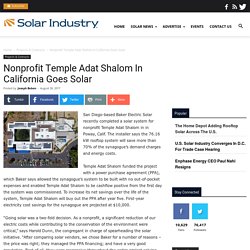
The installer says the 76.16 kW rooftop system will save more than 70% of the synagogue’s demand charges and energy costs. Temple Adat Shalom funded the project with a power purchase agreement (PPA), which Baker says allowed the synagogue’s system to be built with no out-of-pocket expenses and enabled Temple Adat Shalom to be cashflow positive from the first day the system was commissioned. To increase its net savings over the life of the system, Temple Adat Shalom will buy out the PPA after year five. First-year electricity cost savings for the synagogue are projected at $10,000.
SEIA Releases New Model PPA For C&I Sector - Solar Industry. The Solar Energy Industries Association (SEIA) has released a new model contract meant to pave the way for more development of solar in the commercial and industrial (C&I) sector.
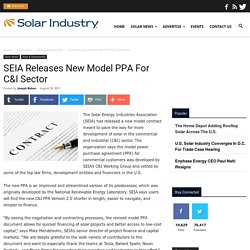
The organization says the model power purchase agreement (PPA) for commercial customers was developed by SEIA’s C&I Working Group and vetted by some of the top law firms, development entities and financiers in the U.S. The new PPA is an improved and streamlined version of its predecessor, which was originally developed by the National Renewable Energy Laboratory. U.S. Auto Dealerships Cruise Toward Savings With Solar - Solar Industry. Like many other businesses, auto dealerships across the U.S. are increasingly adopting solar, and SunPower recently highlighted how its network of solar dealers has helped auto companies make the transition.
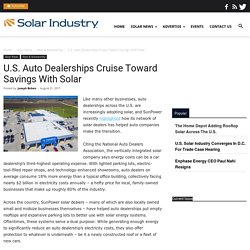
Citing the National Auto Dealers Association, the vertically integrated solar company says energy costs can be a car dealership’s third-highest operating expense. With lighted parking lots, electric-tool-filled repair shops, and technology-enhanced showrooms, auto dealers on average consume 18% more energy than a typical office building, collectively facing nearly $2 billion in electricity costs annually – a hefty price for local, family-owned businesses that make up roughly 80% of the industry. Across the country, SunPower solar dealers – many of which are also locally owned small and midsize businesses themselves – have helped auto dealerships put empty rooftops and expansive parking lots to better use with solar energy systems. Solarindustrymag. Why Is Solar Energy Important?
Source Solar energy is a major renewable energy source with the potential to meet many of the challenges facing the world.

There are many reasons to promote its share in the energy market. This power source is increasing in popularity because it is versatile with many benefits to people and the environment. Importance to Environmental Protection Sunlight received by earth in one hour is enough to meet the annual energy needs of all people worldwide according to National Renewable Energy Laboratory. Green Generation: Millennials Say Sustainability Is a Shopping Priority. Despite the fact that Millennials are coming of age in one of the most difficult economic climates in the past 100 years, a recent Nielsen global online study found that they continue to be most willing to pay extra for sustainable offerings—almost three-out-of-four respondents in the latest findings, up from approximately half in 2014.
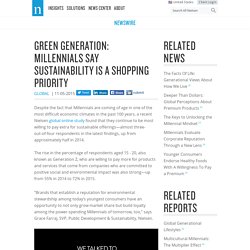
The rise in the percentage of respondents aged 15 - 20, also known as Generation Z, who are willing to pay more for products and services that come from companies who are committed to positive social and environmental impact was also strong—up from 55% in 2014 to 72% in 2015. “Brands that establish a reputation for environmental stewardship among today’s youngest consumers have an opportunity to not only grow market share but build loyalty among the power-spending Millennials of tomorrow, too,” says Grace Farraj, SVP, Public Development & Sustainability, Nielsen. Other findings from the report include: About the Nielsen Global Survey. Hydrologic Rooftop Solar - Commercial Solar Contractor. The Hydrologic Distribution Company is a lighting and plumbing supply company Owned and operated in Tarpon Spring, Florida.
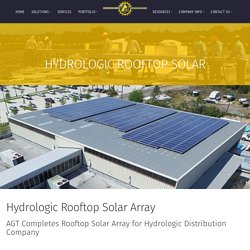
The company provides lighting and plumbing supplies and is a trusted partner for numerous small businesses and entrepreneurs throughout Central Florida. Originally a small enterprise working from a single facility, Hydrologic has quickly grown into multiple locations, allowing them to provide fast, specialized service to each of their valued customers. Advanced Green Technologies (AGT) was chosen to integrate a solar array into Hydrologic’s existing 40-foot, 12,000 square-feet Structural Standing Seam Roof system that would not only provide clean energy to the distribution facility, it would also need to withstand the unpredictability of Florida’s hurricane season and not void the existing roofing systems manufacturer warranty. Why is Commercial Solar a Good Investment?<br /> Solar Investment Returns and the 5 Key Factors<br />
How the Trump Administration Could Pre-Empt State Policies to Shore Up Baseload Power. Sources said that such a move from the Trump administration would be hypocritical and almost unthinkable.
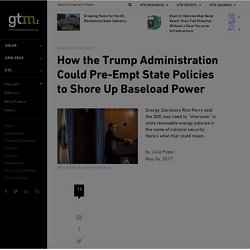
“But who knows!” Said one clean energy stakeholder, who asked not to be named because the details are still murky. “There is a huge amount of erratic policymaking going on. This is not a normal administration. [...] This is not how it’s done. Green Generation: Millennials Say Sustainability Is a Shopping Priority. How much electricity is lost in transmission? « Carbon Counter. How much electricity is lost in transmission?
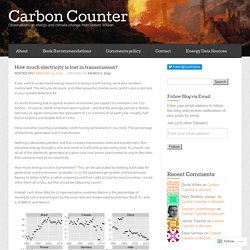
Posted on Updated on If you want to understand energy issues it is always worth having some key numbers memorised. This let’s you do quick, and often powerful, mental sums, and it’s also a vital tool in your bullshit detection kit*. It’s worth knowing that in typical western economies per-capita CO2 emissions are 7-10 tonnes – of course, North Americans aren’t typical – and that the average person in Britain, Germany or Japan consumes the equivalent of 3 or 4 tonnes of oil each year, roughly half that in America and double that in China. Here is another one that is probably worth having somewhere in you mind: The percentage of electricity generation lost in transmission. Nothing is absolutely perfect, and that includes transmission lines and transformers. The Electric Power System is Inefficient. Today’s electric power system is shockingly inefficient in terms of both resource use and the market economy.

Approximately two-thirds of the fuel burned to generate electricity is lost in the generation and delivery process. Or, to put it another way, our electric power system operates at approximately 33 percent efficiency. There has been no improvement in efficiency in the electric power industry since the 1960s. Approximately 5 percent of the waste is the result of “line losses” — essentially power leakage as electricity travels from generator to end user. Line losses are increasing because the system is becoming overloaded. By contrast, cogeneration, recycling waste heat at or near the end-use site, achieves efficiencies of 65 90 percent.
As a result of the system’s inefficiencies, generation of electric power produces more pollution than any other single industry in the United States. The estimated costs of congestion vary depending on the region. Best States For Solar ROI. As many people have pointed out, solar panels aren’t like household appliances, they are more like financial investments. So, the key point many people want to know is, what’s my solar ROI (return on investment). The report summarized below shows the average solar ROI for states across the US, which is pretty cool and interesting. But to get even more specific, you can simply get a solar quote right now that projects you cost of going solar, solar electricity savings, and solar ROI. Check that out, and get in touch with our team to get an even more narrowed down, personalized quote. Now that you’ve done that, check out the state solar ROI rankings below, preceded by some expert commentary from yours truly.
Advantages and disadvantages of a solar tracker system. A version of the article first appeared in a blog by mounting provider Solar FlexRack. Read the company’s blog here. The Solar FlexRack Series TDL solar tracking system. Solar trackers are rising in popularity, but not everyone understands the complete benefits and potential drawbacks of the system. Solar panel tracking solutions are a more advanced technology for mounting photovoltaic panels. Stationary mounts, which hold panels in a fixed position, can have their productivity compromised when the sun passes to a less-than-optimal angle. Comparing the ROI of a Solar Tracker vs. Fixed Mount Solar. As a solar installer, you want to find a solar solution that performs well, lasts for a long time and, perhaps most importantly, produces a strong return on investment for your clients (and, in turn, your business).
To help you make your decision, we've taken a deep dive to compare the ROI of fixed-mount and solar tracker systems. When it comes to cost, the difference between fixed solar (whether it be roof- or ground-mount) and solar tracker systems generally comes down to whether you want to spend less money up front, or save considerably more over the life system. Benefits of fixed PV Systems Fixed-mount systems typically cost less initially, when using the traditional measure of dollar per watt. However, customers won't be making as much return on these systems over time, as they tend to produce less energy than tracking systems.
Appraising into the Sun: Six-State Solar Home Paired-Sales Analysis. Lost In Transmission: How Much Electricity Disappears Between A Power Plant And Your Plug? How much energy is lost along the way as electricity travels from a power plant to the plug in your home? This question comes from Jim Barlow, a Wyoming architect, through our IE Questions project. To find the answer, we need to break it out step by step: first turning raw materials into electricity, next moving that electricity to your neighborhood, and finally sending that electricity through the walls of your home to your outlet. Step 1: Making Electricity Power plants – coal, natural gas, petroleum or nuclear – work on the same general principle. Energy-dense stuff is burned to release heat, which boils water into steam, which spins a turbine, which generates electricity. 3 Cool Ways to Finance Community Solar Projects. Thanks to Co-op, Small Iowa Town Goes Big On Solar.
It’s hard to imagine a place more bucolic than the rural farming communities clustered around Kalona, Iowa — the kind of place that for generations has embodied conservative, blue-collar values woven throughout rural America. Nestled in the gently rolling hills of southeastern Iowa, it’s at first difficult to tell what sets Kalona apart from countless similar places on the Midwestern landscape. Small towns like these form the backbone of a region whose economy depends on a rich farming tradition, even well into the 21st century. But Kalona’s charm doesn’t obscure the innovation that makes it a national leader in clean power generation.
A Beautiful Day in the Neighborhood: Encouraging Solar Development Through Community Association Policies and Processes - The Solar Foundation. Energy payback time (EPBT) and energy return on energy invested (EROI) of solar photovoltaic systems: A systematic review and meta-analysis. Current SunShot Incubator Projects. Slideshow: US Residential Solar Outlook—Grid Parity, Rate Design and Net Metering Risk. Solar and energy efficiency need to work together like peanut butter and jelly. 2016 Top 500 North American Solar Contractors. Solar Power World, the industry’s leading source for technology, development and installation news, presents the 2016 Top 500 Solar Contractors list. Better Buildings Residential Program Solution Center. FACT SHEET: Obama Administration Announces Clean Energy Savings for All Americans Initiative. The state of residential solar power. Don't panic, but we will need to generate approximately 15TW of usable energy from renewable (carbon-neutral) sources by 2050 in order to stabilize the atmospheric CO2 concentration.
Public Utility Regulatory Policies Act - Wikipedia. The Public Utility Regulatory Policies Act (PURPA, Pub.L. 95–617, 92 Stat. 3117, enacted November 9, 1978) is a United States Act passed as part of the National Energy Act. Public Utility Regulatory Policies Act - Wikipedia. The new guide to the community solar galaxy. Colorado Settlement to Pay Solar Owners Higher Rates for Peak Power. National Solar Database. 65638. Soft Costs. The U.S. Department of Energy (DOE) SunShot Initiative’s soft costs program works to lower the non-hardware costs of solar and accelerate the adoption of solar energy technologies throughout the United States. In support of the SunShot Initiative goals, the soft costs program works in the following strategic areas: networking and technical assistance, data analysis, business innovation, and training.
Tracking the sun ix briefing. Solar Means Business 2015: Top U.S. Corporate Solar Users. Opening The Floodgates On Clean Energy Deployment In The U.S. Companies Align to Make Rooftop Solar More Accessible - Sustainability: Energy. SEIA Just Debuted Their Community Solar Guide (And It's Pretty Awesome) A Complete Guide to Energy Efficient Home Lighting - Infographic.
These Are the World’s Most Energy Efficient Countries – Infographic. The US Solar Market Is Now 1 Million Installations Strong. Built Environment: Tools and Resources. Residential Energy+ Residential Energy+: Capturing the Primetime Opportunity for Energy- performance Improvements In U.S. Homes. Fannie Mae’s Financing for Solar: A Game Changer for the Solar Industry. Philosophical Transactions of the Royal Society of London A: Mathematical, Physical and Engineering Sciences. U.S. Chamber of Commerce joins anti-solar crusade. AEE PowerSuite: PowerPortal. U.S. Green Building Council. 50sosQ4 FINAL. When Will Rooftop Solar Be Cheaper Than The Grid? Here's A Map - Renewable Energy World. Relative performance of tracking versus fixed tilt photovoltaic systems in the USA - Drury - 2013 - Progress in Photovoltaics: Research and Applications. Con Edison Aims to Revamp Customer Service, Saving Energy Too. Can Simple Energy’s E-Commerce Portal Help Utilities Sell More Stuff?
Sunverge Energy. Why We Should Let Utilities Own and Operate Rooftop Solar. Try.enact-systems. Sighten. The Solar Software Summit: How Software Ate Rooftop PV. Changing the power system and utility businesses at their core. From Old to New: How Rethinking Regulation Can Deliver a Smarter Electricity System. Utility Rate Database. LEED Certification, BPI Training, Solar Training, Energy Auditor, RESNET HERs Rater. Crest user manual v 4. Maine%20VOS%20White%20Paper%20V2. Here’s How Electric Cars Will Cause the Next Oil Crisis. Net Energy Metering Guiding Principles. Qualifying Facilities - What is a Qualifying Facility? A new kind of utility: Why SolarCity wants to be 'more than a solar company' Untitled. Inside Georgia Power's move into the residential solar market. Maine%20VOS%20White%20Paper%20V2. Solar - Customer Acquisiton Cost - Khai's personal knowledge vault.
More Solar Records, Lowering Solar Customer Acquisition Costs... (Clean Energy Link Drop) Chapter%205 compressed. A Look at Wind and Solar. Apples to Atoms: Why Comparing Nuclear Costs to Solar Costs Is Misguided. Better, Cheaper Loans Challenging the Solar Leasing Model? SolarCity Kills Its MyPower Loan Product. Determining the Value of Solar Is More Important Than Ever. Determining the Value of Solar Is More Important Than Ever. Lowering Solar Customer Acquisition Costs With Phones, Software and the Cloud. Cleantech and Renewable Energy News and Analysis. A new kind of utility: Why SolarCity wants to be 'more than a solar company' Grid Edge Live 2015: The trends behind the explosion in distributed resources. Presidential candidates on renewable. Today's top solar news read by solar pros. Online Communities. Search. Cleantech and Renewable Energy News and Analysis. 5000 List of Fastest Growing Private Companies.
Growth in residential electricity prices highest in 6 years, but expected to slow in 2015. Consumer Reviews of Solar Companies and Solar Panels. Yingli Solar. Why Use Solar Electricity? The Solutions Project - 100% Renewable Energy.